问答
发起
提问
文章
攻防
活动
Toggle navigation
首页
(current)
问答
商城
实战攻防技术
活动
摸鱼办
搜索
登录
注册
【Web实战】浅谈Reactor Netty HTTP Server目录穿越漏洞(CVE-2023-34062)
渗透测试
Spring官方近期披露了CVE-2023-34062,在 Reactor Netty HTTP Server 中,1.1.x 版本在 1.1.13 之前以及 1.0.x 版本在 1.0.39 之前存在安全漏洞。在特定情况下,攻击者可以通过发送一个特定的 URL 的请求来触发目录遍历攻击。
0x00 关于Reactor Netty HTTP Server ================================ Reactor Netty提供了易于使用和配置的HttpServer。它隐藏了创建HTTP服务器所需的大部分Netty的功能,是用于构建响应式的、非阻塞的 HTTP 服务器的一部分。使得开发者能够方便地构建高性能、响应迅速的 Web 应用。  以下结合实际使用进行简单的介绍: 这里使用 Reactor Netty HttpServer构建了一个简单的 HTTP 服务器,并通过设置一个路由,定义了一个 RESTful 端点 "/hello"。当客户端通过 HTTP GET 请求访问 "/hello" 时,服务器将返回 "Hello, World!" 的响应: 1. 创建 `HttpServer` 实例,指定端口为 8080。 2. 使用 `route` 方法配置服务器的路由,添加了一个处理 "/hello" 路径的处理器,该处理器在接收到请求时发送 "Hello, World!" 的响应。 3. 使用 `bindNow()` 方法启动服务器,并将其绑定到指定的端口。 4. 使用 `onDispose().block()` 方法进行阻塞操作,确保在服务器关闭之前等待所有正在处理的请求完成。是一种优雅关闭服务器的方式。 ```Java DisposableServer server = HttpServer.create().port(8080) .route(routes -> { routes.get("/hello", (request, response) -> response.sendString(Mono.just("Hello, World!"))); }).bindNow(); server.onDispose() .block(); ``` 具体效果如下:  0x01 漏洞描述 ========= Spring官方近期披露了CVE-2023-34062,在 Reactor Netty HTTP Server 中,1.1.x 版本在 1.1.13 之前以及 1.0.x 版本在 1.0.39 之前存在安全漏洞。在特定情况下,攻击者可以通过发送一个特定的 URL 的请求来触发目录遍历攻击。 具体而言,如果通过 Reactor Netty HTTP Server 配置用于提供静态资源,那么应用程序就可能存在风险。  **影响版本** - Reactor Netty - 1.1.0 to 1.1.12 - 1.0.0 to 1.0.38 - 更旧的不再支持的版本 0x02 原理分析与复现 ============ 以reactor-netty-http-1.0.35为例进行分析。 根据漏洞描述,当通过 Reactor Netty HTTP Server 配置用于提供静态资源,那么应用程序就可能存在风险。 查阅官方文档https://projectreactor.io/docs/netty/release/reference/index.html#\_static\_resources ,这里提供了通过reactor.netty.http.server.HttpServerRoutes#file方法,用于配置处理静态文件的路由规则的案例: 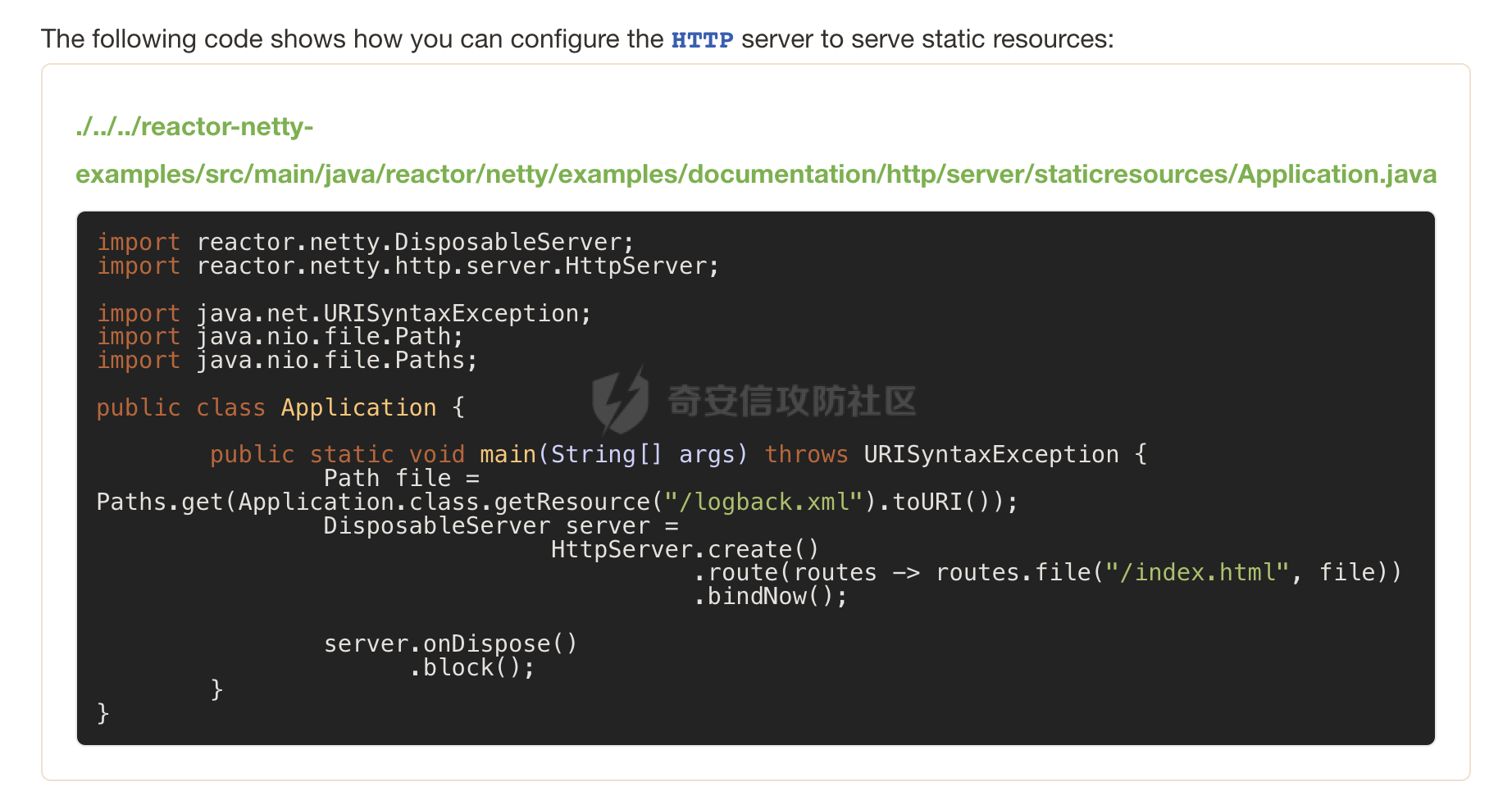 根据对应的方法,搭建具体环境测试: 这里以映射/tmp目录下的test.txt文件为例:  ```Java Path file = Paths.get("/tmp/test.txt"); DisposableServer server = HttpServer.create().port(8080) .route(routes -> { routes.file("/hello",file); }).bindNow(); server.onDispose() .block(); ``` 启动服务后访问/hello成功读取到对应test.txt文件的内容:  在Reactor Netty中设计了一个HttpServerRoutes接口,该接口继承了BiFunction,用来路由请求。当请求到达时,会根据设计的路由规则,按顺序依次查找,直到完成第一个匹配,然后调用对应的处理handler。HttpServerRoutes接口内针对常用的get、head、post、put、delete等请求类型分别设计了相应的路由规则。 首先看下reactor.netty.http.server.HttpServerRoutes#file的具体实现:  最终实际调用的方法如下,当请求的 URI 满足指定的条件时,将根据文件路径path处理 HTTP 请求,发送相应的文件内容。如果文件不存在或不可读,将发送空的响应:  因为path参数在一开始就是硬编码设置好的,所以在这里尝试进行目录穿越也是没办法读取到/etc/passwd内容的:  在HttpServerRoutes接口中可以看到,除了file方法以外,还可以使用reactor.netty.http.server.HttpServerRoutes#directory方法配置静态资源:  通过 `routes.directory(String url, Path directory)` 配置,指定了服务器应该从文件系统的 directory参数目录中提供静态资源。这表示对于该路径下的文件,服务器将直接返回它们的内容给客户端,而不是执行任何处理逻辑。 这里创建了一个简单的Web服务器,配置了静态资源目录为/tmp,对于该路径下的文件,服务器将直接返回它们的内容给客户端,不会执行任何处理逻辑: ```Java public static void main(String[] args){ Path file = Paths.get("/tmp"); DisposableServer server = HttpServer.create().port(8080) .route(routes -> { routes.directory("/tmp",file); }).bindNow(); server.onDispose() .block(); } ``` 通过main方法启动服务,当尝试访问/tmp目录下的文件时,成功返回对应的内容:  查看具体的实现过程,实际的处理主要在reactor.netty.http.server.DefaultHttpServerRoutes#directory方法: 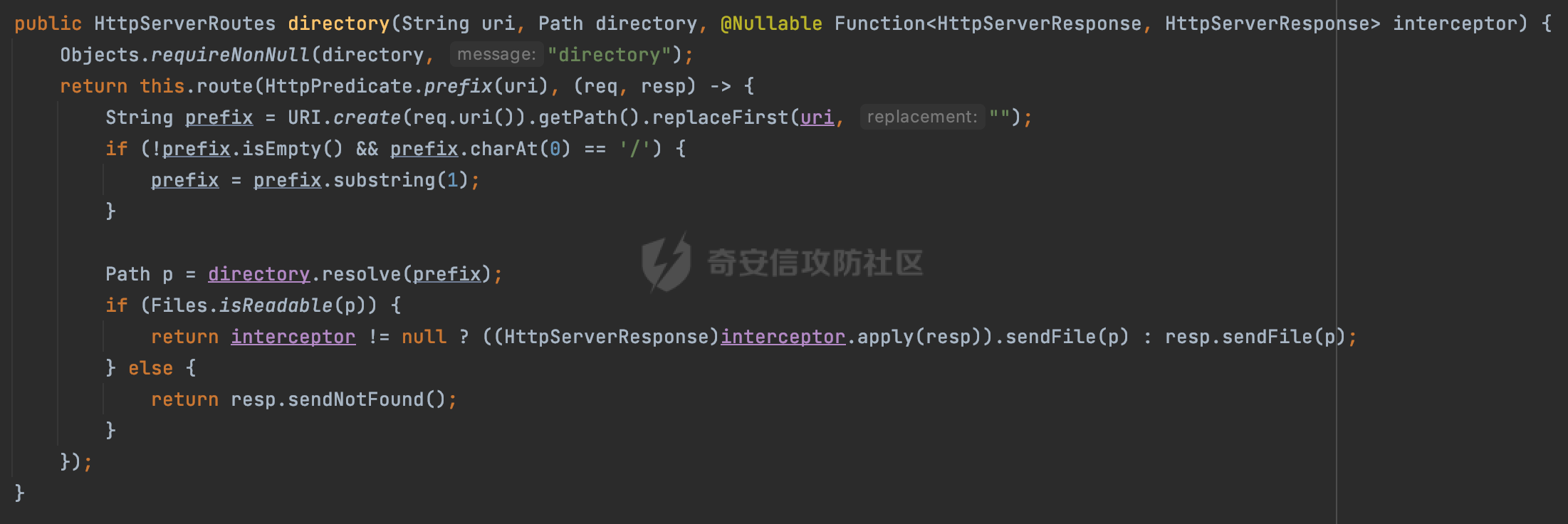 首先使用 route 方法配置一个路由规则。这个规则基于 HttpPredicate.prefix(uri),表示当请求的 URI 以指定的 uri 前缀开头时,应用这个路由规则,在下面的逻辑里会定义路由规则的处理器,方便处理符合条件的 HTTP 请求:  这里会获取请求的 URI,并通过 replaceFirst(uri, "") 去除 URI 中的指定前缀,得到请求的相对路径 prefix,如果相对路径`prefix`不为空且以斜杠`/`开头,将斜杠去除:  然后构建文件系统路径,使用`directory.resolve(prefix)`将相对路径`prefix`解析为绝对路径: 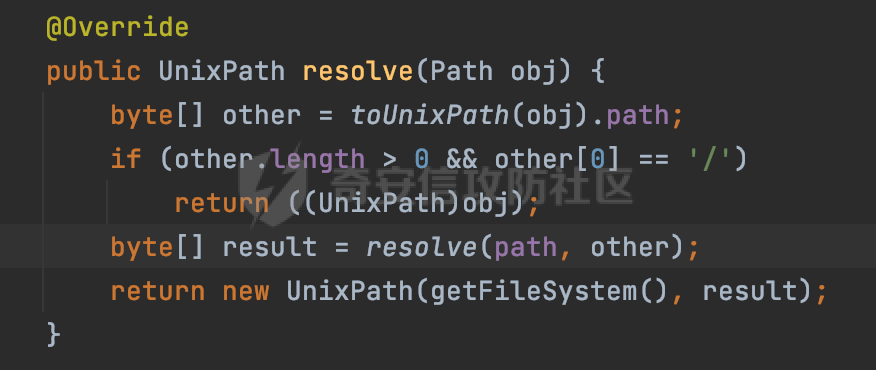 具体resolve方法的实现,这里这主要是实现了两个字节数组(表示Unix系统中的路径)的解析和合并操作: 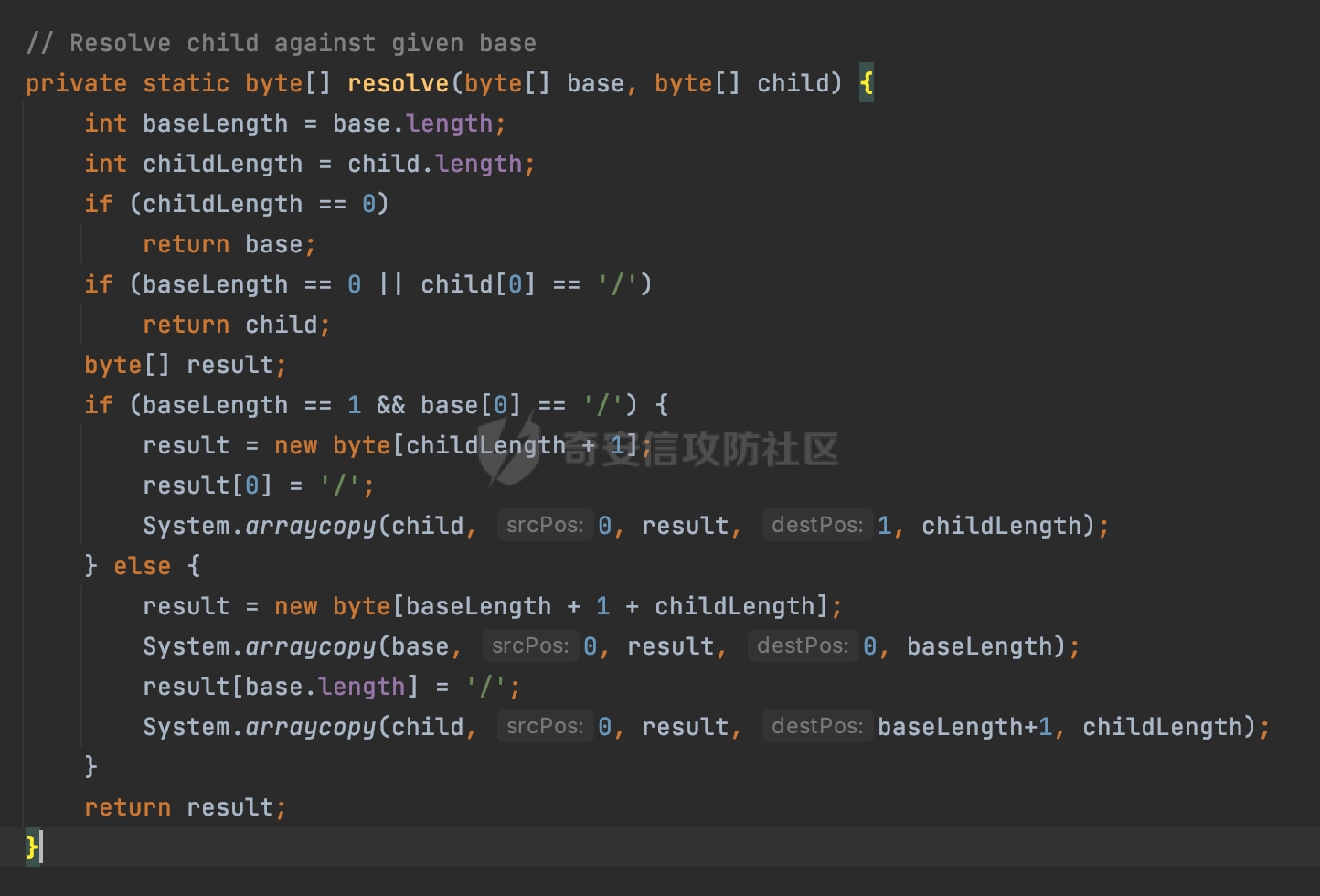 处理完后检查处理后的路径是否可读。如果可读,表示存在相应的静态资源,将执行以下操作: - 如果存在拦截器 (interceptor != null),则使用拦截器处理响应,并通过 sendFile(p) 发送文件内容。 - 如果没有拦截器,直接通过 resp.sendFile(p) 发送文件内容。 - 如果路径不可读,表示静态资源不存在或不可访问,通过 resp.sendNotFound() 返回 404 Not Found。  根据前面的分析,**整个过程并没有对uri中类似../目录穿越符进行处理**直接拼接到Path中读取文件内容,此时可以目录穿越读取其他路径下的文件,并直接返回它们的内容给客户端。 同样是上面的例子: 直接在uri上引入目录穿越符`../`尝试读取/etc/passwd的内容,可以看到由于缺少对应的安全措施成功目录穿越读取到对应的内容:  综上所述,**当使用存在漏洞版本的Reactor Netty 且通过reactor.netty.http.server.HttpServerRoutes#directory方法配置静态资源访问时,可能存在目录穿越的风险**。 0x03 修复方式 ========= 主要的修复在reactor.netty.http.server.DefaultHttpServerRoutes#directory方法,相比之前的逻辑,这里会调用`normalize()`方法将路径标准化,即解析任何`.`(当前目录)和`..`(上一级目录)的引用,如果规范化后的请求资源路径不是以设置的静态资源目录开头的话,返回resp.sendNotFound,表示内容不存在。通过对请求内容的规范化处理避免了目录遍历的风险: 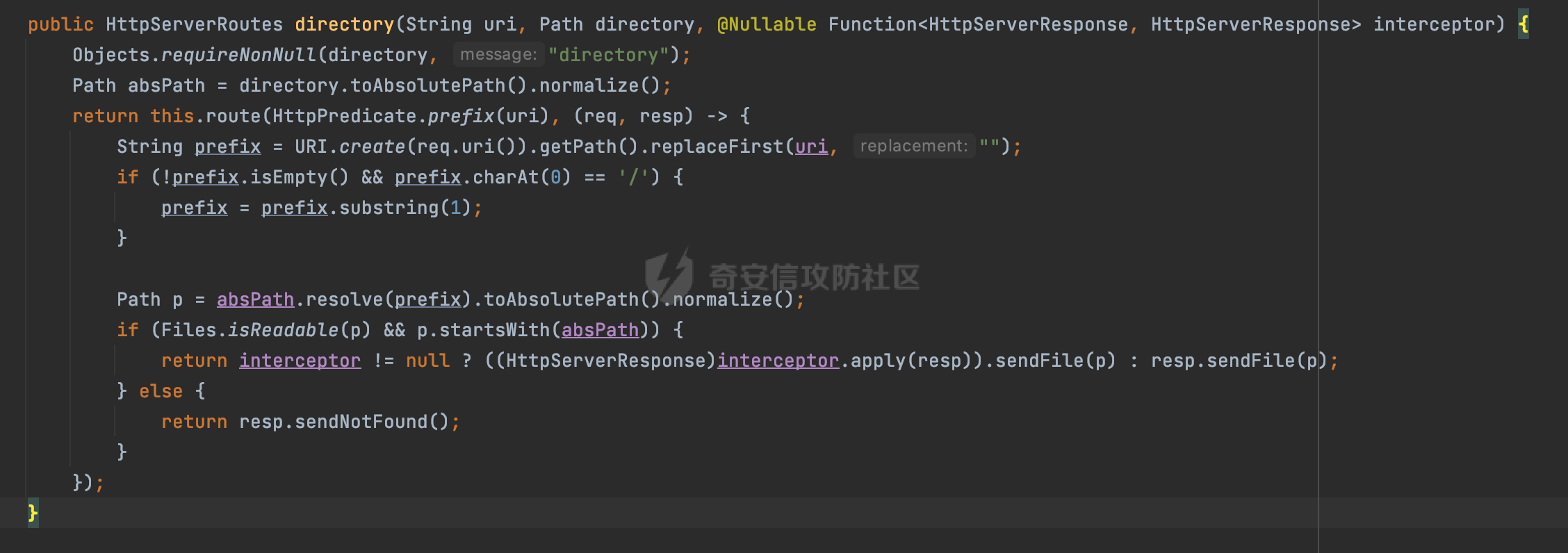 同样是上面的例子,在pom中显式依赖1.0.39安全版本的Reactor Netty:  此时再次尝试结合目录穿越符去读取/etc/passwd的内容,返回404 status,利用失败: 
发表于 2023-11-27 09:00:00
阅读 ( 21110 )
分类:
漏洞分析
0 推荐
收藏
0 条评论
请先
登录
后评论
tkswifty
66 篇文章
×
发送私信
请先
登录
后发送私信
×
举报此文章
垃圾广告信息:
广告、推广、测试等内容
违规内容:
色情、暴力、血腥、敏感信息等内容
不友善内容:
人身攻击、挑衅辱骂、恶意行为
其他原因:
请补充说明
举报原因:
×
如果觉得我的文章对您有用,请随意打赏。你的支持将鼓励我继续创作!